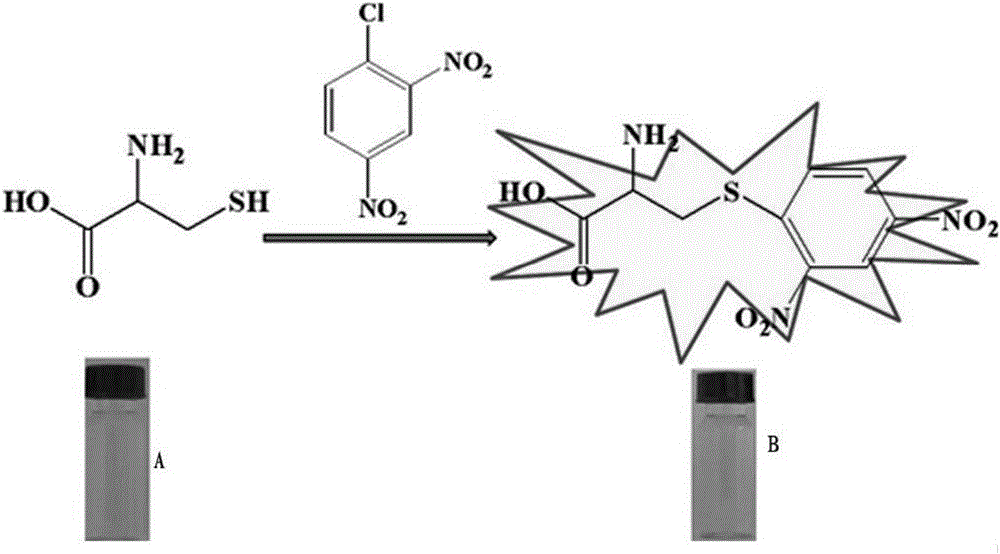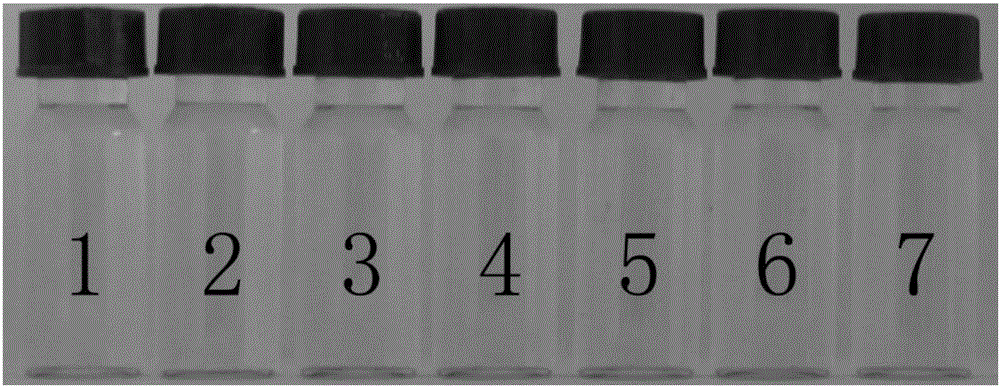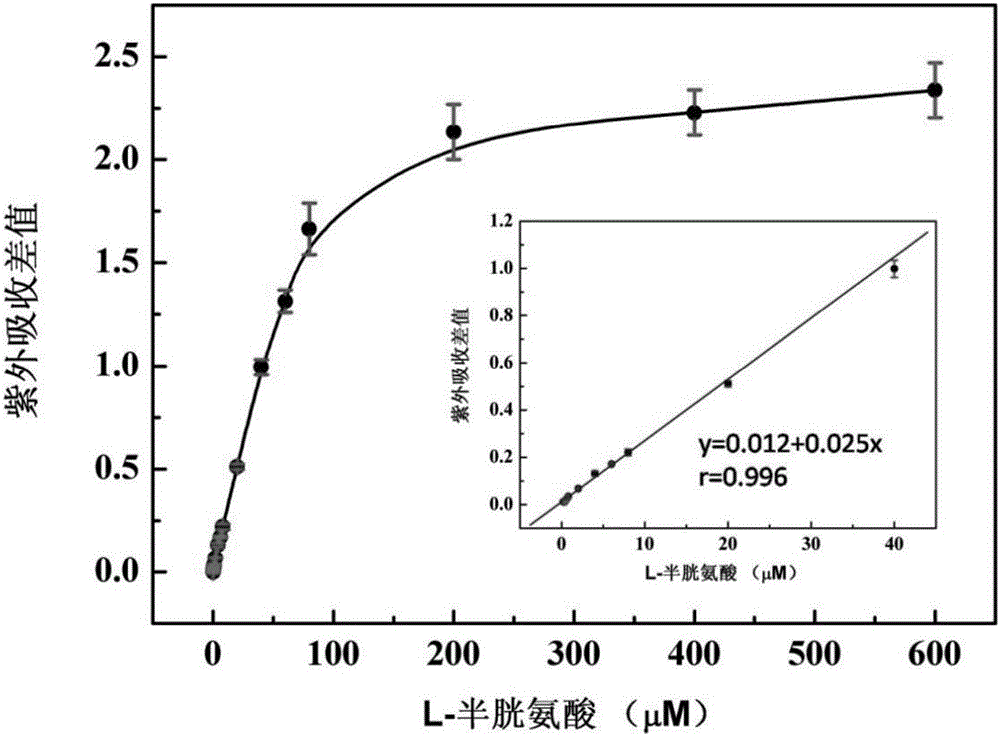A simple and rapid method for detecting l-cysteine
A cysteine, rapid technology, applied in color/spectral characteristic measurement, material analysis by observing the influence on chemical indicators, analysis by making materials undergo chemical reactions, etc., can solve the problem of high detection limit, selection Problems such as poor performance and low sensitivity
- Summary
- Abstract
- Description
- Claims
- Application Information
AI Technical Summary
Problems solved by technology
Method used
Image
Examples
Embodiment 1
[0028] Example 1: Determination of L-cysteine concentration in pig liver.
[0029] (1) Sample acquisition: take fresh pig liver
[0030] (2) Sample pretreatment: Cut 2g of sample into pieces with tissue scissors, put it into a 10ml vial, then add deionized water to make up the volume to 10ml, and then homogenize with a homogenizer. Add the same volume of ethanol to the homogenate to remove protein and other impurities, mix thoroughly and centrifuge at 10,000 rpm for 10 minutes, and take the supernatant. The supernatant was filtered with a 0.22 μm membrane filter, and the filtrate was diluted 10 times for later use.
[0031] (3) Take 800 μl of the sample to be tested and add 100 μl of solution A.
[0032] (4) Add 15 μl of solution B and 5 μl of solution C to the liquid obtained in step (3), and react for 5 minutes in a boiling water bath.
[0033] (5) Concentration adjustment: If the color of the reaction solution obtained in step (4) is too yellow, the sample to be tested...
Embodiment 2
[0039] Example 2: Determination of the concentration of L-cysteine in pig liver by standard addition.
[0040] (1) Obtaining of samples: take fresh pig liver.
[0041] (2) Sample pretreatment: Cut 2g of sample into pieces with tissue scissors, put it into a 10ml vial, then add deionized water to make up the volume to 10ml, and then homogenize with a homogenizer. Add an equal volume of ethanol to the homogenate to remove protein and other impurities, mix thoroughly and centrifuge at 10,000 rpm for 10 minutes, and take the supernatant. The supernatant was filtered with a 0.22 μm filter membrane, the filtrate was diluted 10 times, and 5 μM standard L-cysteine was added for use.
[0042] (3) Take 800ml of the sample to be tested and add 100μl of solution A.
[0043] (4) Add 15 μl of solution B and 5 μl of solution C to the liquid obtained in step (3), and react for 5 minutes in a boiling water bath.
[0044] (5) Concentration adjustment: If the color of the reaction solutio...
Embodiment 3
[0049] Implementation Example 3: Concentration spike determination of L-cysteine in pig liver.
[0050] (1) Obtaining of samples: take fresh pig liver.
[0051] (2) Sample pretreatment: Cut 2g of sample into pieces with tissue scissors, put it into a 10ml vial, then add deionized water to make up the volume to 10ml, and then homogenize with a homogenizer. Add an equal volume of ethanol to the homogenate to remove protein and other impurities, centrifuge at 10,000 rpm after thorough mixing, and take the supernatant. The supernatant was filtered with a 0.22 μm membrane filter, the filtrate was diluted 10 times, and 10 μM standard L-cysteine was added for use.
[0052] (3) Take 800ml of the sample to be tested and add 100μl of solution A.
[0053] (4) Add 15 μl of solution B and 5 μl of solution C to the liquid obtained in step (3), and react for 5 minutes in a boiling water bath.
[0054] (5) Concentration adjustment: If the color of the reaction solution obtained in step...
PUM
| Property | Measurement | Unit |
|---|---|---|
| wavelength | aaaaa | aaaaa |
Abstract
Description
Claims
Application Information
 Login to View More
Login to View More - R&D
- Intellectual Property
- Life Sciences
- Materials
- Tech Scout
- Unparalleled Data Quality
- Higher Quality Content
- 60% Fewer Hallucinations
Browse by: Latest US Patents, China's latest patents, Technical Efficacy Thesaurus, Application Domain, Technology Topic, Popular Technical Reports.
© 2025 PatSnap. All rights reserved.Legal|Privacy policy|Modern Slavery Act Transparency Statement|Sitemap|About US| Contact US: help@patsnap.com



